Rice Paper & Noodles




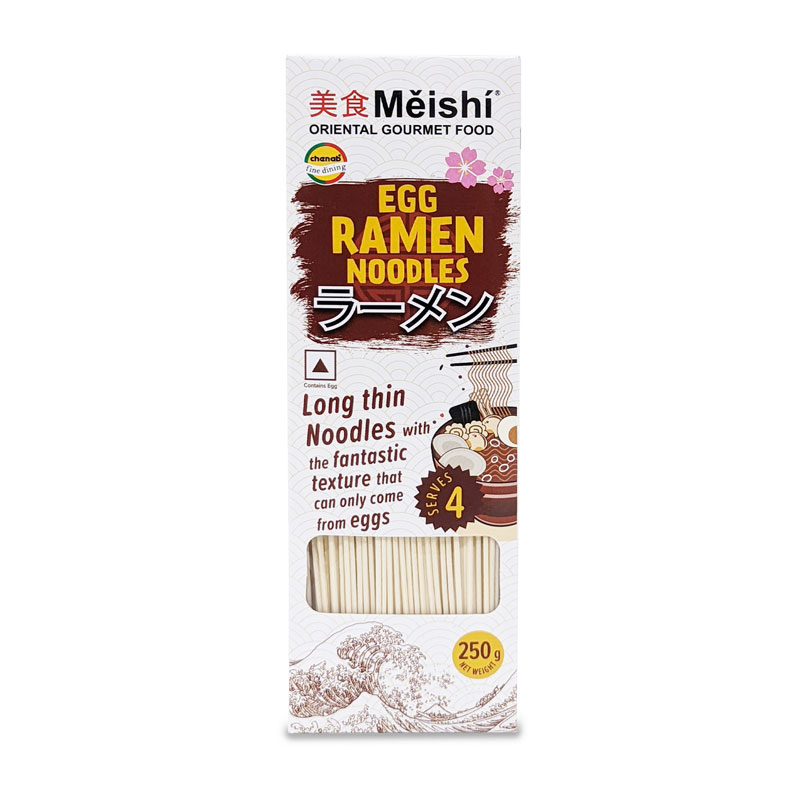
With Meishi, Chenab takes you on a journey through the Orient by bringing for you authentic ingredients from Thailand, Vietnam, Japan, Indonesia, Malaysia.With varities of Noodles, rice paper sheets, vermicelli, Meishi has launched some quick cooking, dried noodles – Soba, Udon and Ramen. Noodles are a staple of Japanese cuisine. The popular Japanese noodles are Soba (Whole Wheat and Buck Wheat), Udon (Refined wheat) and Egg Ramen (Refined wheat, Eggs).They are often served chilled with dipping sauces, or in soups or hot dishes. Noodles were introduced into Japan from China during about 1000 years ago. Ramen noodles are a relatively thin, long and bouncy noodle that originated in China, but is now most often associated with Japan. Egg Ramen are thin, wheat-based noodles made using wheat flour and eggs, which are mixed and formed into a dough, cut into flat strips, and then cooked in boiling water, it has a springy, firm texture. The dough is risen before being rolled. Ramen noodles have a firm texture and make a great accompaniment to soups, stir-frys or salads, or can be enjoyed the way they are typically prepared – along with a rich bowl of broth.
Refined wheat flour, (Maida), Eggs, water and salt.
250g
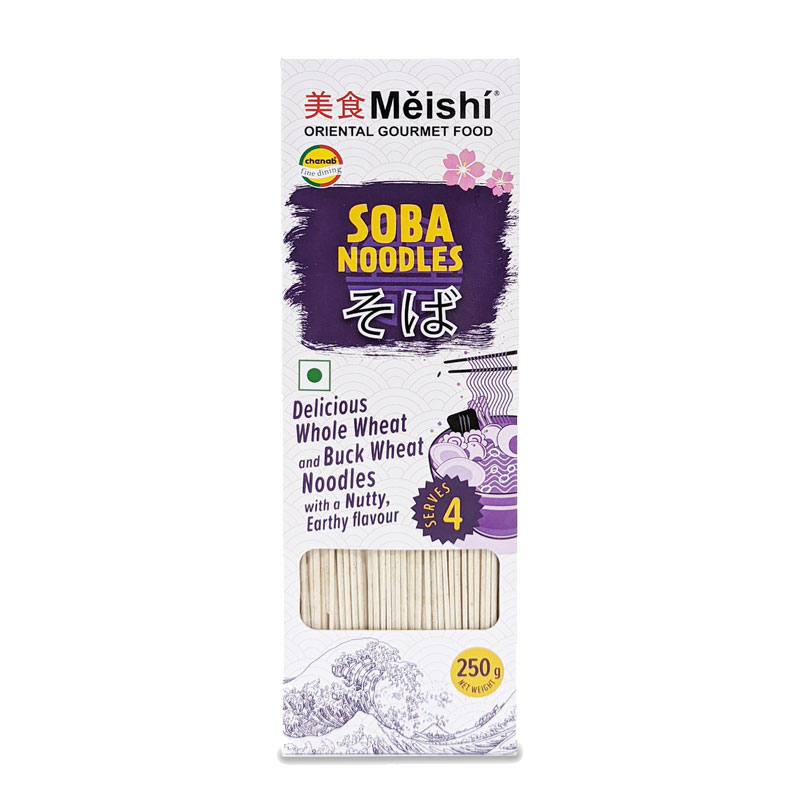
With Meishi, Chenab takes you on a journey through the Orient by bringing for you authentic ingredients from Thailand, Vietnam, Japan, Indonesia, Malaysia. With varieties of Noodles, rice paper sheets, vermicelli, Meishi has launched some quick cooking, dried noodles – Soba, Udon and Ramen. Noodles are a staple of Japanese cuisine. The popular Japanese noodles are Soba (Whole Wheat and Buck Wheat), Udon (Refined wheat) and Egg Ramen (Refined wheat, Eggs).They are often served chilled with dipping sauces, or in soups or hot dishes. Meishi Soba noodles are thin Japanese noodles made by combining buckwheat flour, along with a some amount of wheat flour and water, mixing to form a crumbly dough, then rolling out that dough into a flat sheet which is then folded and hand-cut into slender strands about the thickness of spaghetti. Buckwheat is a pseudocereal grain, harvested from the seeds of non-grasses. They are Nutty and earthy in flavor, slightly chewy consistency, along with a color that ranges from pale tan to brownish-gray, depending on the proportion of buckwheat flour, as soba noodles are made of buckwheat they may be one of the healthiest noodles to eat! Soba noodles can be eaten either cold or hot. Hot ones are usually served in a bowl of steaming broth, with the side dishes placed in a soup or on a separate plate while cold ones are eaten by dipping them into a small bowl of sauce known as tsuyu. Soba is typically eaten with chopsticks, and in Japan, it is considered acceptable to slurp the noodles noisily. Like many Japanese noodles, soba noodles are often served drained and chilled in the summer, and hot in the winter with a soy-based dashi broth. Extra toppings can be added to both hot and cold soba, on the other hand Soba is a comparatively healthy food. An individual serving of soba noodles contains roughly 300-400 calories and has lots of vitamins B1 and B2, lutein, dietary fiber, minerals, and protein, with very little fat. Done in about 15 minutes, they're covered in a zingy sauce of soy, sesame oil, rice vinegar, and honey and sprinkled with toasted sesame seeds. They're perfect as a component for a fast and easy dinner.
Whole wheat flour (Atta), Buck Wheat flour, Water and salt.
250g
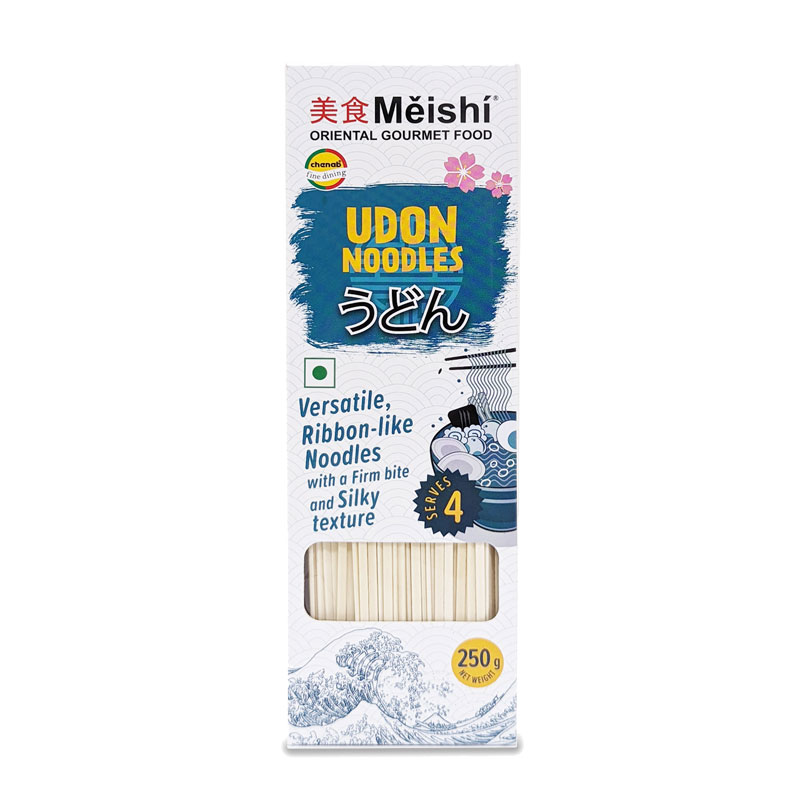
With Meishi, Chenab takes you on a journey through the Orient by bringing for you authentic ingredients from Thailand, Vietnam, Japan, Indonesia, Malaysia. With varieties of Noodles, rice paper sheets, vermicelli, Meishi has launched some quick cooking, dried noodles – Soba, Udon and Ramen. Noodles are a staple of Japanese cuisine. The popular Japanese noodles are Soba (Whole Wheat and Buck Wheat), Udon (Refined wheat) and Egg Ramen (Refined wheat, Eggs).They are often served chilled with dipping sauces, or in soups or hot dishes. Meishi Udon noodles are made out of refined wheat flour, they are thick and white in color, best as fresh, they are versatile ribbon like noodles with a firm bite and silky texture. Due to their neutral flavor, they are able to absorb strong-flavored ingredients and dishes. They are specially used in Japanese cuisine. It is a comfort food for many Japanese people. There are a variety of ways it is prepared and served. It is usually topped with thinly chopped scallions. More unusual variants include stir-fried yaki udon and curry udon made with Japanese curry. It is often used in Japanese hot pot. Udon noodles are boiled in a pot of hot water. Depending on the type of udon, the way it is served is different as well. Udon noodles are usually served chilled in the summer and hot in the winter. Due to the mild taste, udon noodles are great to use with strong flavors and ingredients. Meishi Udon noodles are typically served as a noodle soup in a hot broth, but they can also be served cold, with a dipping sauce. Some of the more popular udon dishes are Kake udon, Curry udon, Yaki udon.
Refined wheat flour (Maida), water and salt.
250g

Meishi fine rice vermicelli is a traditional Vietnamese dish that's comprised of woven fine rice vermicelli noodles topped with chopped scallions in oil. It's never eaten alone, but instead as a lettuce wrap with a complimentary meat dish and a variety of vegetables and herbs.
This is a Vegetarian product.
400 g
Vietnam
.jpg)
Meishi Rice Vermicelli is a thin white noodle made from rice one can serve this noodles in the bottom of big bowls for a great taste you can add the vermicelli with boiled vegetables, tomato, and fried tofu soup commonly eaten for breakfast; rolled into spring rolls and served next to grilled meat adds a flavor to it.
This is a Vegetarian product.
400 g
Vietnam
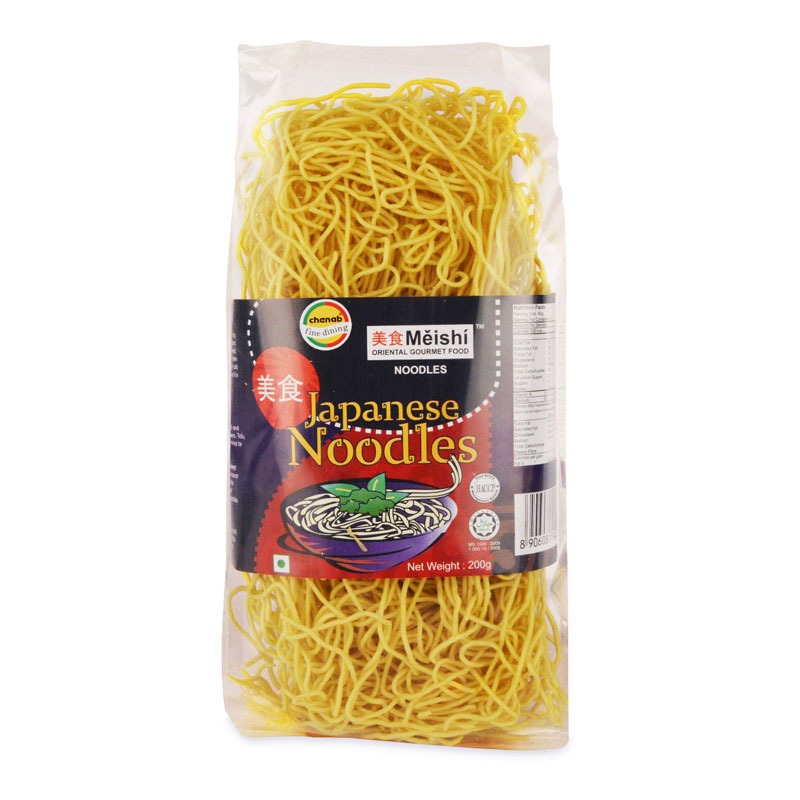
Japanese ramen is different from the Chinese ramen, and it is said to be the most favorite food among foreign tourists to Japan. It is said that Japanese ramen has a flavor that foreign tourists who have come to Japan for the first time have yet to taste. It is that taste attracts people from around the world. To enjoy both the noodles and the soup, ramen with futomen is recommended.
This is a Vegetarian product.
200 g
Malaysia
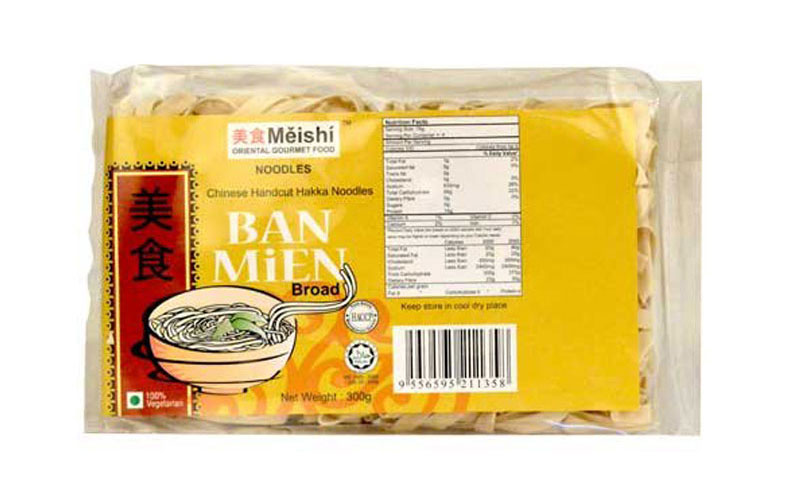
Noodles are an important ingredient in oriental cuisines. Noodles originated from china, whence they migrated eastwards to japan and westwards to south Asia. No oriental meal can be complete without noodles. Asian wheat noodles are typically made from low-or moderate – protein flours and are formed not by extrusion but by sheeting and cutting or stretching. The hand-pulled noodles of shanghai ( la mian) are a fine example, in which the maker starts with a thick rope of dough, swings, twists and stretches it to an arm's length, brings the ends together, repeats the process as many as 11 times to make more than 4000 thin noodles. Asian wheat noodles are both elastic and soft, their texture created by their weak gluten and amylopectin – rich starch in the wheat. Salt is an important ingredient in asian noodles. It tightens the gluten network and stabilizes the starch granules, keeping them intact even as the absorb water and swell. We begin with the meishi white wheat Chinese noodles, ban mian style (hand-cut hakka noodles) – both – broad as well as fine. You may prefer the broad noodles for the ban mian soup and the fine noodles for stir-fry with veggies or meat. The ingredients are wheat flour, salt, and water.
This is a Vegetarian product.
300 g
Malaysia
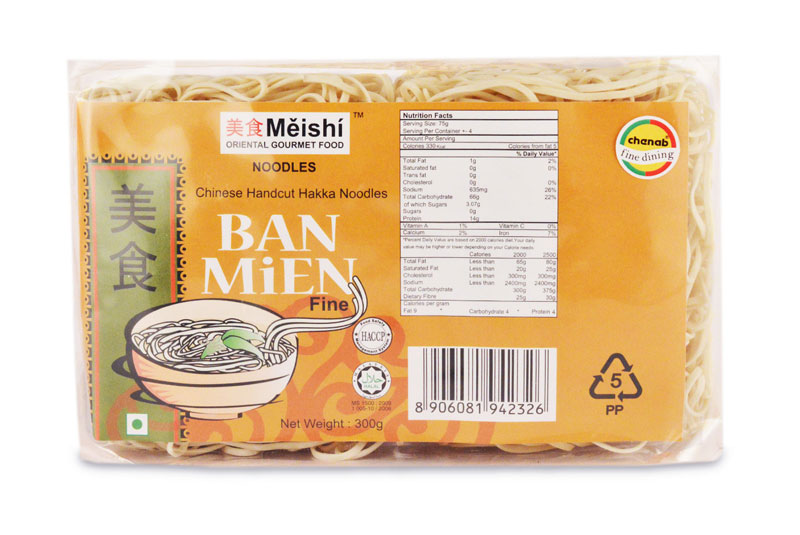
Cook the noodles with soup adding butter and seasoning, add tofu, meat or vegetables according to choice. Serve as cooked noodles with butter, oyster mushroom, Chinese sauce, or stir fry with broccoli, snow peas, and pepper.
This is a Vegetarian product.
300 g
Malaysia

The staples of Vietnam's noodle scene. Like the melody of a song, the different notes compliment each other so that you can pick what you fancy depending on your mood. The thick and luscious rice noodles are there to warm you on cold winter days. As with most of Vietnam's creative culinary traditions, there are noodles that fall outside of the three major categories, regional specialties that are worth seeking out and hunting down.
This is a Vegetarian product.
300 g
Malaysia

"Indomie Mi Goreng is an instant noodles product line made under the Indomie brand by the Indofood company. Indomie Goreng is a type of instant noodle served without soup and is stirred well with soy sauce, oil, and seasoning. This instant noodle derived its inspiration from the traditional Indonesian dish called mi Goreng, a variant of fried noodle common in Indonesia. This product has gained a cult following in Indonesia and in various other countries, such as Nigeria and Australia.1. Prepare the noodles according to the package directions; drain and set aside. 2. In a wok or large skillet, heat the oil and add the onion, garlic, and ginger; stir fry until the onion is limp. 3. Stir in the leeks or scallions, snow peas, and bean sprouts, and cook until tender-crisp. 4. Then stir in the noodles, kecap manis, and sambal or cayenne. 5. Add the eggs or tofu. 6. Mix thoroughly until heated through (about 5 minutes). 7. Serve hot.
This is a Vegetarian product.
300 g
Malaysia
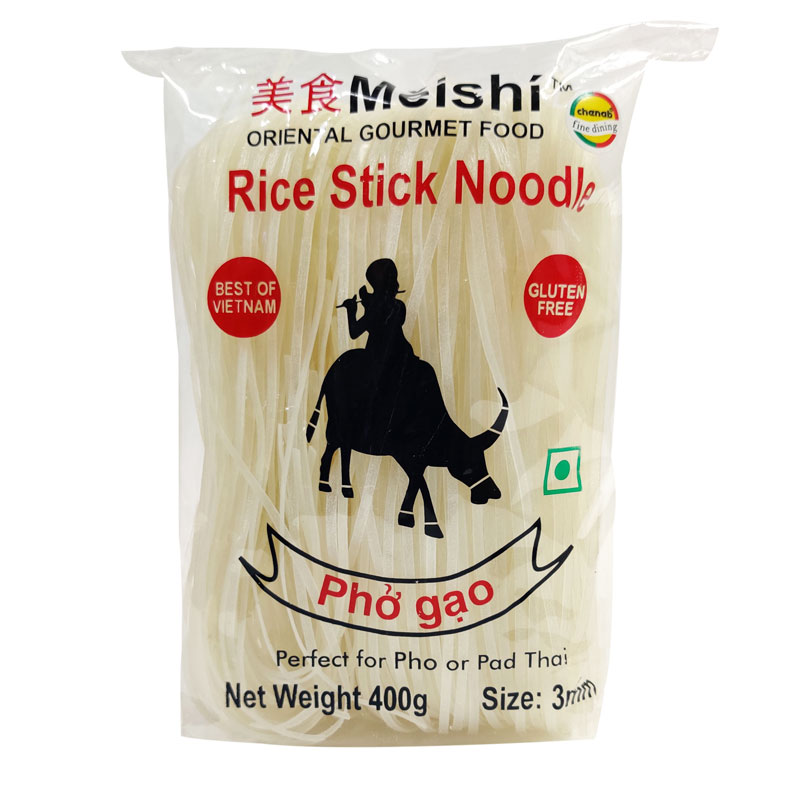
There are many kinds of rice noodles used in Asian cooking. Like Italian pasta, the shape and size of Asian rice noodles determine how they're used. For pho noodle soup and other pho noodle dishes, you wanting pho —flat rice noodles. These noodles in Vietnam are employed to eat with grilled or roasted meats. Flat rice noodles are sold in different widths to match cooking applications, they are used in Vietnamese. People also use these noodles in soup with vegetables.
This is a Vegetarian product.
Rice Flour 85%, water 14.9%, Salt 0.1%
400 g
Vietnam
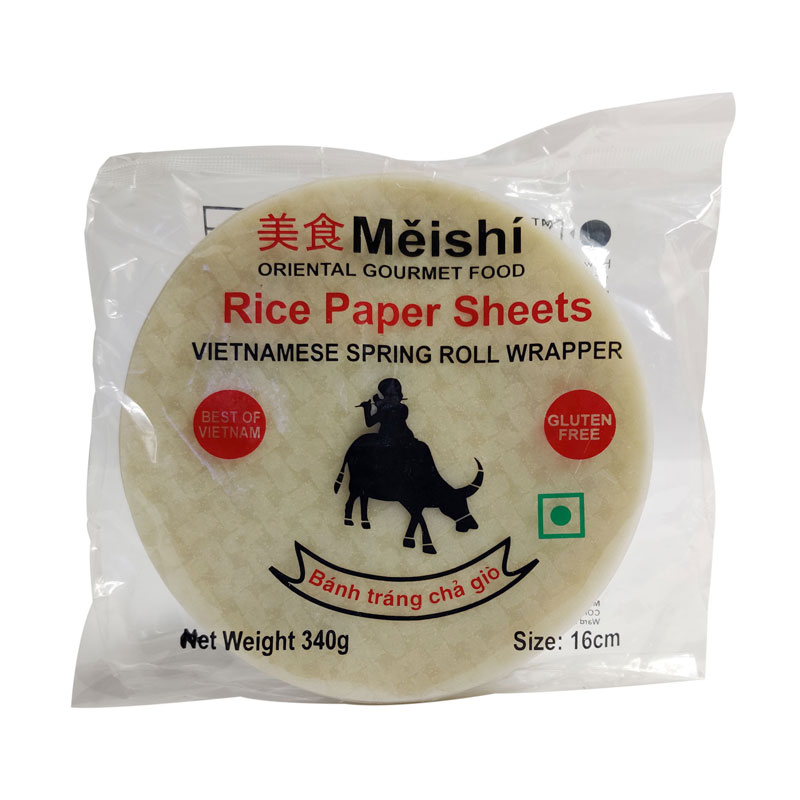
For a fan of spring rolls, these Rice Paper Spring Roll Wraps from meishi are an easy-to-prepare and very healthy option. They are the perfect ingredient to make those delicious wraps or spring rolls. Simply soften rice paper by dipping in cold or warm water for 2-3 seconds. Lay flat on a plate and is ready for wrapping your favorite stuff…like vegetables, herbs, meat, shrimp, rice stick noodle…etc.
This is a Vegetarian product.
340g
Vietnam